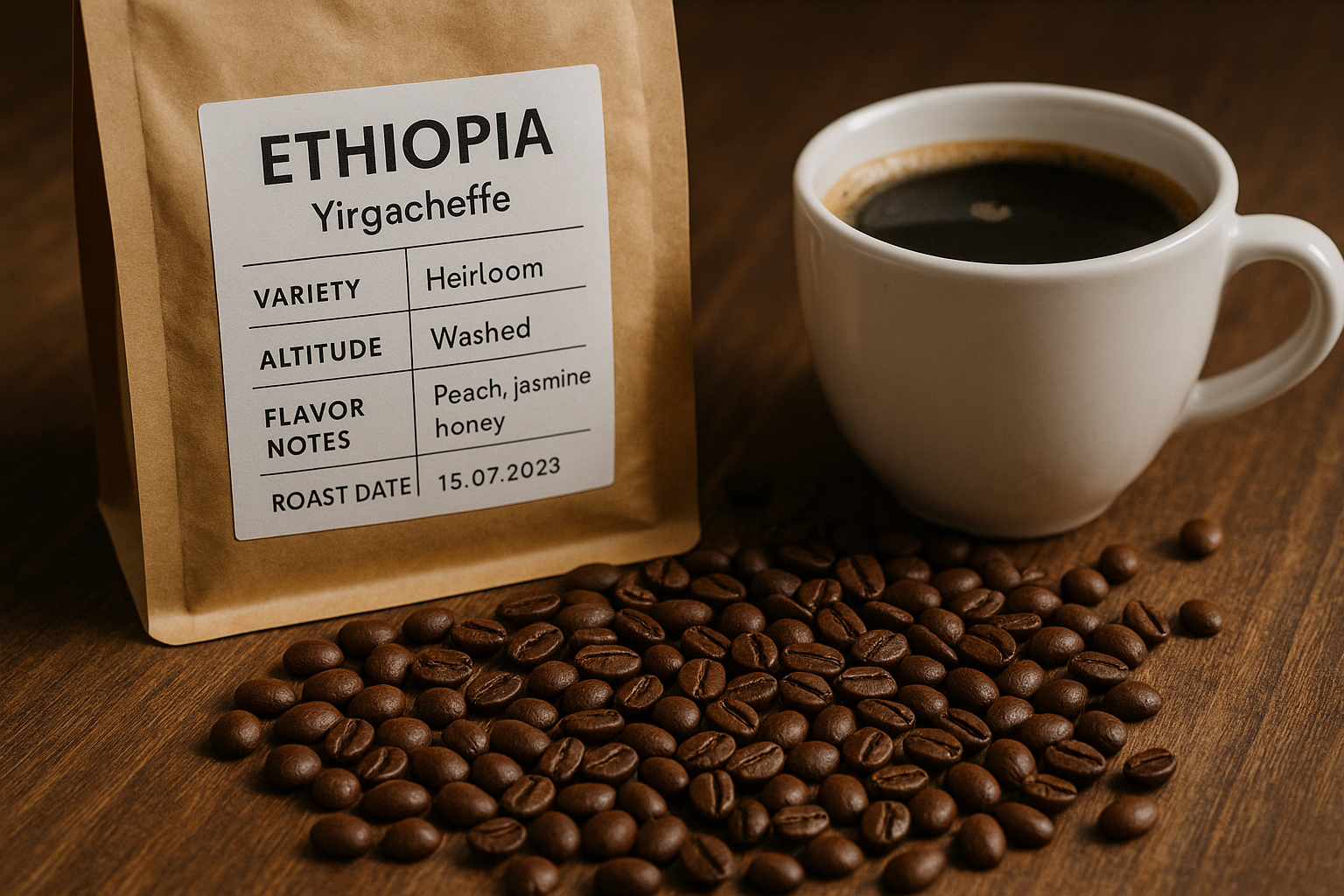A bag of specialty coffee often comes with a label packed full of information—origin, processing method, roast date, altitude, tasting notes, and more.
While it may seem overwhelming at first, this information is gold for any barista who wants to understand, serve, and explain their coffee with confidence.
Knowing how to decode a coffee label helps you dial in your brews, communicate better with roasters, and guide your customers to coffees they’ll truly enjoy. It’s also a sign of professionalism and respect for the complex journey of the coffee bean.
The Importance of Traceability
One of the most valuable features of specialty coffee labels is traceability. This means the coffee can be tracked back to a specific country, region, cooperative, or even farm.
Traceability adds transparency to the supply chain and gives credit to the producers. For baristas, it provides context for flavor and helps build customer trust.
If a label mentions “single origin” or “micro-lot,” it usually indicates high traceability and unique flavor characteristics. These coffees often stand out in competitions, pour-over bars, and curated tasting menus.
Origin: More Than Just a Country
Most labels list the country of origin, but many go further by including the region, farm, or cooperative. Each origin brings its own flavor tendencies based on terroir and processing practices.
Examples:
- Ethiopia, Yirgacheffe: Known for floral and citrusy coffees.
- Colombia, Huila: Balanced sweetness, red fruits, and chocolate.
- Kenya, Nyeri: Bright acidity with berry and blackcurrant notes.
- Brazil, Cerrado: Low acidity with nutty, chocolatey flavors.
Understanding these regional profiles helps baristas select beans based on intended flavor profiles or brewing methods.
Variety (Cultivar): A Flavor Blueprint
Just like grapes in wine, coffee comes in varieties (cultivars) such as Bourbon, Typica, SL28, Caturra, and Gesha. These names often appear on specialty labels and signal both agronomic traits and flavor potential.
For example:
- SL28 (Kenya): Juicy acidity, berry flavors, and a wine-like body.
- Gesha (Panama/Ethiopia): Floral, tea-like, and highly aromatic.
- Caturra (Latin America): Balanced and approachable, often chocolatey.
Baristas who understand these varieties can anticipate flavor profiles and communicate them effectively to customers seeking specific sensory experiences.
Processing Method: How It Shapes Flavor
The processing method listed on a label tells you how the coffee cherry was turned into a green bean—and it dramatically affects taste.
- Washed (Wet): Fruit removed with water; clean, crisp, and bright flavors.
- Natural (Dry): Cherry dried intact; fruity, sweet, sometimes funky or winey.
- Honey: Mucilage left on during drying; rich body and balanced sweetness.
- Anaerobic or Fermented: Experimental processes; intense, layered, or funky notes.
Knowing the process allows baristas to adjust grind size, brew method, and ratios to highlight or tame specific flavor attributes.
Altitude: A Clue to Acidity and Density
Many labels mention elevation, typically measured in meters above sea level (masl). Higher-grown coffee tends to develop more slowly, resulting in denser beans and higher acidity.
- 1,200–1,500 masl: Balanced profile, medium acidity.
- 1,500–1,800 masl: Brighter, fruitier, more complex.
- Above 2,000 masl: Highly structured, vibrant acidity, intense floral notes.
Knowing elevation helps you anticipate bean hardness, which affects grind size and extraction, especially in espresso preparation.
Roast Level and Date: Critical for Brewing
Two of the most practical pieces of information on any label are the roast level and roast date.
- Light Roast: Best for pour-over, retains origin characteristics.
- Medium Roast: Balanced, good for espresso and filter.
- Dark Roast: Low acidity, rich body, often suited for milk drinks.
Always check the roast date, not “best before.” Coffee is freshest 3–21 days after roasting. For espresso, many prefer to wait 7–14 days for degassing.
Using coffee too fresh or too old can result in inconsistent shots, bland cups, or extraction problems. Baristas should rotate stock and taste regularly to monitor freshness.
Flavor Notes: Interpreting the Descriptors
Flavor notes listed on labels (e.g., “peach, jasmine, caramel”) are not added ingredients—they are the result of sensory evaluation during cupping.
These notes are meant to guide expectations, not to promise specific flavors. They’re often subtle and subjective, varying with brewing method and personal palate.
Tips for baristas:
- Use flavor notes to adjust your brewing—a fruity note may shine more in a V60, while chocolate notes are enhanced in espresso.
- Help customers understand that notes are suggestions, not artificial flavors.
Certifications and Labels: Ethics and Quality Signals
Many specialty coffee labels include certifications that baristas should recognize:
- Fair Trade: Ensures minimum price and ethical treatment of workers.
- Organic: Grown without synthetic pesticides or fertilizers.
- Rainforest Alliance: Focuses on environmental and social standards.
- Direct Trade: No universal standard, but implies direct sourcing and better pay for farmers.
Certifications provide talking points when educating customers or answering questions about sustainability and ethics.
Grind Recommendations and Brew Guidelines
Some bags include suggested brew methods or recipes (e.g., “Best for espresso,” or “Use 1:16 ratio”). These tips are useful starting points, especially for baristas working with new or unfamiliar coffees.
Use them as a baseline, then adjust based on your grinder, machine, water, and desired flavor outcome. Don’t rely on them blindly—taste is always the final judge.
What Labels Don’t Always Tell You
Not all important information fits on a label. If you want to go deeper:
- Visit the roaster’s website for farm stories, videos, and extended tasting notes.
- Ask your coffee rep or roaster for cupping data or sourcing details.
- Use apps or QR codes (some bags include these) for traceability and brew guides.
Being informed beyond the label allows you to answer questions and elevate the customer’s experience.
How to Teach Customers About Labels
Baristas can use labels as educational tools:
- Walk customers through a bag when recommending retail beans.
- Compare two coffees by label (origin, roast, process) and offer samples.
- Create a chalkboard or card display that decodes common label terms.
Empowering customers to read labels makes them more confident buyers and more engaged coffee lovers.
Final Thoughts: Labels Are Your First Clue
Every coffee label is a compact story waiting to be explored. It holds details that help you choose, prepare, and explain the coffee with precision and purpose.
Baristas who take the time to read and understand labels are better equipped to brew consistently, create memorable service, and showcase the craftsmanship behind every bean.
Next time you pick up a new bag, don’t just scan for the flavor notes. Look at the whole label—it’s your first step to unlocking the full potential of what’s inside.

Artur is a coffee enthusiast and content creator passionate about barista techniques and coffee culture. With a sharp eye for detail and a love for learning, he shares practical tips, brewing guides, and gear insights to help readers elevate their coffee experience — from home brewers to aspiring professionals.
